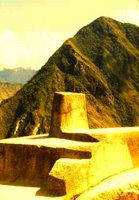
This year in New England, my corner of the world, winter yielded early to spring, which has unfolded fully into summer. The summer solstice heralds the season’s official calendrical arrival, but the days are already long, hot and bright. I wake early now to spears of gold light penetrating my slatted blinds and dawn bird song sifted and scattered by my window screen.
For ages, humans have waited, yearned, prayed for the sun’s seasonal return. They’ve made offerings and built temples to it, devised formulas and calendars foretelling its reappearance, and charted its apexes and nadirs in their skies. They’ve organized their lives, planted their crops and undertaken their voyages according to its place in their heavens.
Each year when summer spreads its rays of light and heat across my bit of Earth, I think of the great granite slab that rests atop Machu Picchu in Peru. Machu Picchu is a place of a lifetime, and every inch of it brings wonder. But the gray rock altar, hand-hewn centuries ago into strikingly powerful geometry, especially touched me. The mass sits on a cliff edge thousands of feet above the brown-green Urubamba River, and it seemed to me to be reaching, communicating beyond its stone roots into the sky and past the place where Earth’s air ends.
Indeed, the monolith’s ancient Inca carvers intended nothing less. The rounded stone spur that rises from the altar’s base is called the Hitching Post of the Sun, Intihuatana in Quechua. Here, Inca astronomers performed ceremonies to ensure the sun’s permanence. Through Intihuatana, they predicted with precision key dates, times of year and planting seasons. During solstices and equinoxes, Intihuatana’s edges align with significant geographic and geologic features in the surrounding mountain landscape, vivid proof of the Incas’ broad awareness of, reverence for and connection to the natural world they inhabited.
To celebrate June’s summer solstice, descendants of the Inca will celebrate Inti Raymi, the festival of the sun, and ancient places like Cusco and Machu Picchu will fill with natives and visitors gathered to thank the sun for continuing to shine.
Many will hike to and stand beside Intihuatana, "the place where the sun is tied," to contemplate the invisible tether that hitches a brilliant, distant life-giving orb to silent rock.
www.LoriHein.com
